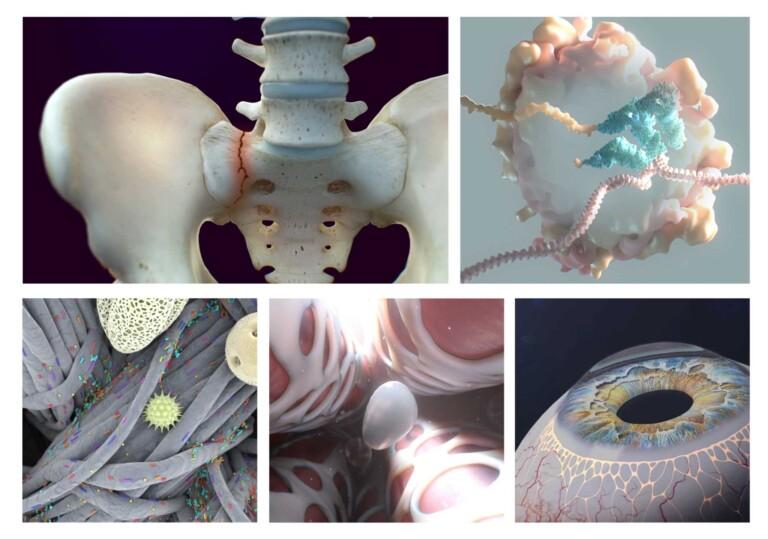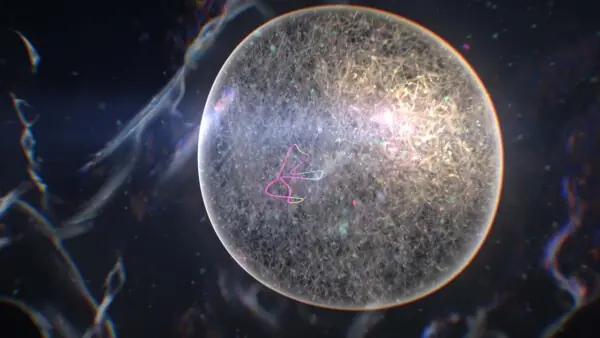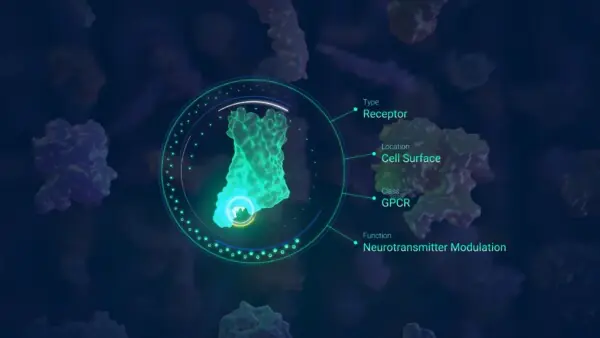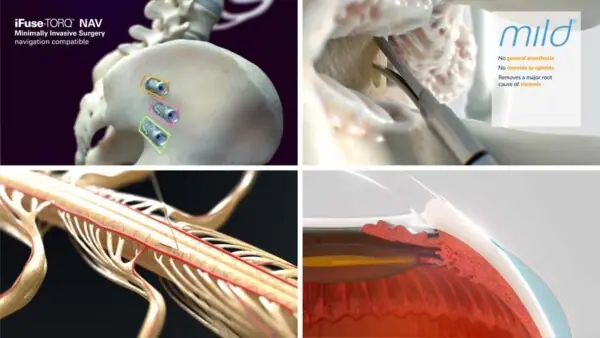
How Much Does Medical Animation Cost and Why?
By Cameron Slayden, M.S.
If you're reading this article, you're probably struggling to find a fair answer to the question: How much does medical animation cost? The easy answer is that medical animation studios can be divided into three groups: budget-oriented studios that range from $2,000-$10,000 per minute, midrange medical animation studios that cost anywhere from $20,000 to $40,000 per minute of finished animation, and full-service advertising agencies that charge $80,000 per minute or more.
The typical animation project will usually range between one and three minutes in duration. This means the average project will be between $2,000 and $300,000 in total, depending on which studio you choose.
Obviously, that's the kind of response that raises more questions than it answers. Specifically, what could possibly cause two orders of magnitude of variation in rates?
Without understanding what drives the budgetary structure, you could end up in continuous revisions, trying to explain complex science to artists with no scientific background. You could end up getting just the right kind of high-end animation you want, but paying double what you needed to. Worst case scenario: you could compromise on showcasing your story and brand in the best light.
In this article, I’ll lay out the considerations that drive costs when producing scientific and medical animation. From there, you’ll better understand how to avoid choosing the wrong provider based on pricing alone, and have a strong sense of where to start when looking for a scientific animation studio.
After you know how much you want to spend on animation, this article will help you see what each studio offers for the price.
To start, I’ve broken the price range into three pricing models. Let’s talk about what you get for your money when you spend at the low, mid and high price tiers.
3 Tiers of Medical Animation Price Points
Low Price-Point: Rapid Turnaround, Light on Science
The lowest price point will deliver animations designed to tell a story in an engaging way but not necessarily unpack complicated scientific concepts.
These might be whiteboard-style videos, two-dimensional animated diagrams, or other highly stylized representations that are designed to convey overall concepts but not intended to stand up to rigorous scientific scrutiny.
It’s important to note that the studios that charge the least will generally possess the least scientific expertise (scientific staff costs money, after all). That being said, they are perfectly suited for value proposition explainer videos and very short timelines. These studios are under economic pressure to create the highest volume of work in the shortest amount of time to remain profitable.
Often, this is useful to biotech startups during the earliest stages of generating investment. Education-focused groups with limited budgets also benefit, especially when they need to explain science without diving deep into cellular and molecular details.
Middle Price-Point: The Goldilocks Zone for High Production Value
This pricing model is generally used by boutique studios that make scientifically accurate animation their central service offering. While there is a lot of variation among studios concerning to style, production quality, customer service, and approach to storytelling, you can usually trust them to get basic scientific details right without endless rounds of revision.
The middle price point is ideal when it’s time to enhance confidence in your brand while explaining your science in a way that will both engage and impress your audience.
Microverse Studios operates at this price point. Our clients are typically looking for animation to add to a larger campaign or for biotech and pharmaceutical startups headed toward a Series B+ raise or drug commercialization.
If this describes you, consider requesting a quote after reading this article.
Upper Price-Point: Part of a Larger Service Offering
The highest tier will generally yield the same animation quality as the middle tier studios, with the same variations in production quality and style.
The key difference is that these agencies usually offer animation as a part of a much larger service package tailored to the needs of Big Pharma. As a result, numerous staff are dedicated to things other than animation that contribute to overhead.
Often they will have their own in-house animation staff. However, when needed, big agencies will frequently outsource to mid-tier studios. They know those studios have the scientific and production infrastructure to get the job done right, but at a budget that still has room for mark-up. Microverse Studios often works with such agencies.
Hopefully, by breaking out ways production infrastructure can impact cost, this article will give you a look under the hood at how a studio is run and help you choose the provider that best suits your needs.
My Medical Animation Pricing Methodology
Every scientific animation studio is structured differently, and some likely have different or combined versions of the roles listed here. I've done my best to include those most important cost contributors to producing high-quality scientific animation.
A lot of these calculations rely on assumptions of how many minutes of animation a given creative will participate in per year. From there, they figure out how much of their salary goes into each minute of the animation they create. Studios have their own workplace cultures and, therefore, make different demands of their animators.
More punishing workloads will push up profits and drive down prices, but this will also tend to drive staff turnover and reduce production quality. In an ideal world for both the animator and the client, a scientific animator will be able to produce ten to fifteen minutes of animation per year, if they focus on one project at a time. This is the approach Microverse Studios takes.
Additionally, because most scientific animation studios are relatively small (under 30 employees), I'm leaving out things like an IT department, mortgage or rent on a large facility, security, janitorial services, and so forth that come with managing a staff of hundreds. I'm also not including the costs associated with software, subscriptions, workstations, and so forth that as a whole contribute under $500 to the costs of any given project.
| How Medical Animation Studios Resemble Cartoon Studios |
| I recently met with an old friend who is an Emmy award-winning casting director in Hollywood. He told me that the budget for a 3D animated cartoon series for Nickelodeon tops out at a million dollars for a 20-minute episode. That's $50,000 per minute of Ninja turtles fighting wacky enemies, and it has to cover all of the overhead from script to screen. Keep in mind that the animation is also all outsourced to India or South Korea. In the same way, medical animation budgets also need to support every aspect of the studio, not just the cost of the talent and hardware producing the animation. There are direct and indirect costs. For example, the fact that you’re even able to find a studio when you do a search is one of those indirect costs that the price of every animation has to fund. |
Direct and Indirect Costs of Medical Animations
Direct cost: Medical Animators
The median salary for a medical animator in the United States with an advanced degree is $83K per year. Let's round that up to $95k in order to include payroll tax and benefits. After holidays and time off, that amounts to a cost of around $475 per day for actual production work or $9,140 per month.
Given a standard schedule of about two months of solid work dedicated to a one-minute animation, if only one person were to work on it during that time, you'd be talking about $18k for the talent alone.
Often, this price point can be achieved by using freelancers. However, multiple animators need to be involved with a project due to the complexity of the stories we tell and client timelines, especially if the project scope is on the large side and time is short.
Because it makes up such a large component of the cost, talent is a tempting area for studios to cut corners. Shortening the amount of time an animator will spend on any given project is one way. Doubling up an animator's workload is another. It cuts their time commitment to a project by half and significantly increases profit, potentially at the expense of both projects.
Another way to cut costs is to hire non-scientific animators. A non-scientist animator's salary averages $62k in the US, while the average animator in India will be paid one-twentieth of that.
Regardless of the method, cutting costs via talent is a risky choice to make. The less scientific background an animator has, the more likely they are to introduce informational errors into the project that can undermine the customer brand and/or viewer confidence in the message. Therefore, they will require increased oversight, either from the studio's in-house scientific officer or from the client.
A combination of selecting low-cost talent and shortening the number of hours spent on any given project is the only way a studio can operate in the $10,000 per minute range and still remain solvent. That doesn't necessarily make them a terrible choice, but it will be important to remember that the burden will be on the client to educate the animators and make sure all of the science is correct.
Conversely, the more scientifically educated the creatives are, the more nuanced their work will be, and the less oversight and scrutiny needed to maximize a project's potential. If you're looking for a studio to simply hand out a few scientific papers before unleashing them, you'll want a place where everyone has a master's degree or above.
| Case Study: “How do you get your animators to do accurate work?” |
| I had a conversation with a colleague who runs a small scientific animation studio in the UK, and he asked how we manage accuracy at Microverse Studios. In his experience, it could be very difficult to get an animator to create sufficient work. The constant corrections resulted in rounds of revision that were exhausting for him, for the animator, and for the client. Even simple concepts such as the difference in size between a protein and a cell or which direction DNA turns aren't common knowledge, and life sciences are packed with these kinds of tripping hazards. For a non-scientist to do the work, everything has to be explicitly laid out and micromanaged. My answer was that, like some other medical animation studios, we only hire animators with graduate degrees and strong molecular and cellular biology backgrounds. Of course, that drastically reduces the talent pool we have to work with because animators with that combination of cinematic skill and scientific acumen are very rare. It's one of the reasons I chose to moonlight as medical animation faculty at two biomedical visualization graduate schools: the rate of scientific discovery is speeding up. The world needs all the high-end scientific animators it can get. |
Direct Cost: Computing Resources
Every animation goes through a rendering process, in which the virtual camera in the virtual scene takes a virtual picture and saves it as a real image, a frame in the animation.
This is very computationally intense, and all of the tricks we use to make our imagery beautiful only increases those requirements. Usually, the rendering process takes too much time to carry out on a single workstation unless a lot of corners have been cut. To get the best results, most studios employ what's called a "render farm," or a computing array dedicated only to the rendering process.
For a long time, these dedicated computers were maintained on-site, often by an IT staff. Increasingly in recent years, however, rendering tasks are sent to off-site supercomputing resources such as Amazon's AWS or, what we use, Conductor by Coreweave.
This does two things:
- It reduces the render time from days or weeks to mere minutes, allowing much more iteration and improvement.
- It eliminates the obsolescence and maintenance costs of a local render farm.
Regardless of whether the farm costs consist of an upfront investment that is slowly being recouped or an on-demand, off-site, pay-as-you-go solution, the cost contributes to the animation budget.
Depending on the computational requirements for each individual project and the animators' ability to optimize for rendering, computing costs can range from $500 to $3,000 per minute.
Cutting corners on rendering to save costs is not advisable because it reduces production quality and, therefore, the overall value of the project to the client.
Direct Cost: Audio and Narration
Most of our animations are narrated by professional voice talent that we have developed relationships with over many years. They range from $500 to $1,500 per project, depending on the talent.
| Case Study: Oscar Winners Cost More |
| A couple of years ago, a client desperately wanted us to secure J.K. Simmons as the voice for their animation. We reached out to his agent to explain the situation, and they came back with the rate of $75,000 for a 2-year license (he had just won his first Oscar). It broke our client's heart, but they had to decline. In the end, they used their own CEO's voice, who turned out to be shockingly good. |
Indirect Costs: Non-Animation-Producing Staff
Content Experts/Science Officers
Even with highly educated and experienced animators, sometimes a client will still want the studio to provide PhD-level oversight.
The typical budget for a content expert is going to range from $3,000 to $5,000 for a project.
It's a good thing, too. A carefully chosen creative team with the right background can bring a lot of scientific insight. This often means experts only need to give small comments and quickly approve the work.
We had one project where the content expert’s entire contribution was to change one word in the script we wrote.
Production Management
Most studios that produce a significant volume of animation have at least one person dedicated to making sure that all of the moving parts of the production process work together smoothly: the production manager.
This person looks out for issues with the schedule, tracks down assets the animators need, and makes sure that the deliverables get to the client. If they are an especially high-quality person like our own Teal Quinn, they watch the animators to make sure they aren't working themselves to the point of burnout.
The production manager doesn't directly create animation themselves, but their salary contributes around $1-5k to the budget of each project, depending on how many projects they oversee at once.
Creative Direction
The creative director's job is to make sure that all of the imagery stays cohesive and follows the planned vision for its look and feel. This is especially important in larger projects that require multiple animators. Often, they are also responsible for coming up with the creative vision for the story from the start.
They also double as a form of quality control, pushing the animators to do their best and making sure that no corners get cut. They will ensure that a studio's work maintains a consistent standard across projects, which works to the client’s advantage.
Typically, creative directors are very experienced and have spent time in multiple production roles that give them the perspective and cinematic mastery they need to guide a project to its best possible outcome.
While it is possible to create animation without this kind of oversight, the creative director's absence can be easily felt in the end quality of the video. Depending on how many projects they oversee, the creative director's salary contribution to a project's cost will generally be similar to the production manager’s, at around $2-5,000.
Account Executives
This person's primary function is to be a liaison to the clients to make sure that their needs are being met. Often, this role is also a sales role because they will nurture connections between projects and help to guarantee that clients will continue to come back again and again.
Even if there is no formal account executive position in a company, somebody is putting the time in to do account executive work. A good account executive is worth their weight in gold because they help to sculpt the customer experience and drive new business.
The account executive’s salary will contribute around $2,000 to a given animation's overall cost.
Sales and Marketing
Getting in front of clients is the most critical part of every business. No studio will survive if it doesn't make its presence known. While there are certain best practices in marketing, there are as many approaches to customer outreach as there are scientific animation studios.
These could include direct outreach to customers via phone or email, website development, online ads, costs of attending conferences, salaries and commissions for sales staff, and so on. Every studio has its own secret sauce, and it all adds up to the cost of doing business.
Conventional wisdom is that a sales budget should be between 5% and 25% of total revenue, but it could be a bit more.
For example, an on-site, in-person, relationship-based sales team wooing clients with enormous budgets will generally be much more expensive than a sales strategy that targets clients looking for the cheapest possible solution.
For a studio that specializes in the lowest-budget projects, investing in a strong sales apparatus is equally important because their profit depends on a high volume of work.
Additional Agency Staff
There are important differentiators between a big agency that offers in-house animation and a small, boutique studio that specializes in medical animation as its primary service.
In order to serve the broader needs of large pharmaceutical clients, agencies need to have staff dedicated to branding and strategy development, media buying, public relations, social media management, regulatory compliance, and event management, among other specialty roles.
Their personnel infrastructure is designed to make sure that every creative component, whether it’s animation, booth design, or social media posts, fits seamlessly into a unified strategy that maximizes campaign effectiveness.
No part is separable from any other. This makes them a one-stop shop and extremely useful for big-budget clients but out of reach for smaller startups and clinical-stage companies.
Example of Medical Animation Pricing Breakdowns
Taking all of these components into consideration, the cost breakdown for a 1-minute animation might look something like this for a studio that prioritizes scientific accuracy and cinematic quality but doesn't have an expansive sales team or ancillary staff:
- Talent work hours: $20k
- Rendering: $1k
- Non-animation staff and profit: $10-20k
- Total: $30-40,000
For another studio specializing in meeting extremely tight budgetary requirements, it might look like this:
- Talent work hours: $3k
- Rendering: $0-1k
- Non-animation staff and profit: $3-7k
- Total: $6-10,000
And for a studio specializing in serving the needs of large pharmaceutical companies with all of the associated personnel of a large pharma advertising agency, it might look like this:
- Talent work hours: $30k
- Rendering: $1K
- Non-animation staff and profit: $40-65k
- Total: $70-100k
A Wrap-Up of Medical Animation Costs
Every one of these elements has its own range of costs. Most animation companies don't like to share their rates publicly unless they are confident that theirs is the very lowest because they're afraid that they will drive away potential clients if they aren’t able to give their pitch first.
I contend that this is only true for clients prioritizing cheapness, and that those clients will leave even after hearing the pitch. Clients looking for the best value will view cost as just one of many factors worth considering.
They will also take into account production quality, customer service, the studio's grasp of the science, and whether they like the look of the studio’s work.
Need a Quote for Your Medical Animation Project?
So now you’ve found your way to an article hosted by a top-tier medical animation company that produces work at a mid-tier price. I've been careful to be even-handed throughout this article, but there's a reason why we built Microverse Studios to serve this particular cost tier: it allows us to maximize the art and science of scientific and medical animation for the most discerning clients and audiences.
Our animators are carefully selected for their medical animation talent, each with graduate degrees and years of experience. Our support staff is streamlined and perfectly primed to make every project sail through production without a hitch. Over half of our work is repeat business because our clients love working with us. We're the known quantity that gets it right every time because we pay close attention to our clients' unique needs. Request a quote today and find out how we can bring your scientific story to life!
You might also like

Cameron Slayden is CEO of Microverse Studios, and has over 20 years of experience in biomedical visualization. To find out more, check him and the rest of our team out on the Who We Are page.




